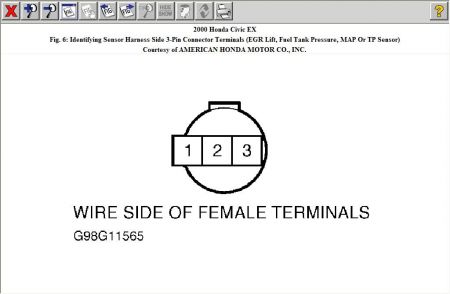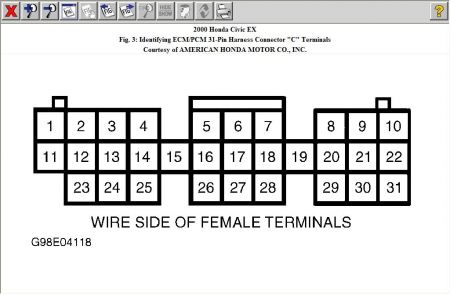Ok,
I got the testing procedures for this code, hope it is helpful.
DTC P0122: THROTTLE POSITION (TP) SENSOR LOW VOLTAGE INPUT
1. Start engine and run at 3000 RPM with no loads and transmission in Park or Neutral until radiator fan comes on. Turn ignition off. Turn ignition on. Using scan tool, check throttle position. If reading is about 10 percent (.49 volt) with throttle fully closed and 90 percent (4.5 volts) with throttle fully opened, problem is intermittent. System is okay at this time. Check for poor connections or loose wires at TP sensor and PCM connectors. See appropriate wiring diagram in WIRING DIAGRAMS article. If reading is not as specified, go to next step.
2. Turn ignition off. Disconnect TP sensor 3-pin connector. Turn ignition on. Measure voltage between TP sensor harness connector terminals No. 1 (Green/Black wire) and No. 3 (Yellow/Blue wire). See Fig. 6 . If about 5.0 volts does not exist, go to next step. If about 5.0 volts exists, go to step 4 .

3. Using backprobe set, measure voltage between PCM 31-pin connector "C" terminals No. 18 (Green/Black wire) and No. 28 (Yellow/Blue wire). See Fig. 3 . If about 5.0 volts exists, check for open in Yellow/Blue wire between PCM 31-pin connector "C" and TP sensor. If about 5.0 volts does not exist, substitute a known-good PCM and recheck. If symptom or indication goes away, replace original PCM.

4. Turn ignition off. Measure resistance between TP sensor connector terminals No. 1 and 2 with throttle fully closed. See Fig. 6 . If resistance is about 500-900 ohms, go to next step. If resistance is not as specified, replace throttle body (TP sensor cannot be serviced separately).
5. Measure resistance between TP sensor connector terminals No. 2 and 3 with throttle fully closed. See Fig. 6 . If resistance is about 4500 ohms, go to next step. If resistance is not as specified, replace throttle body (TP sensor cannot be serviced separately).
6. Reconnect TP sensor 3-pin connector. Turn ignition on. Using backprobe set, measure voltage between PCM 31-pin connector "C" terminals No. 18 (Green/Black wire) and No. 27 (Red/Black wire). See Fig. 3 . If voltage is about 0.5 volt with throttle fully closed and 4.5 volts with throttle fully open, substitute a known-good PCM and recheck. If symptom or indication goes away, replace original PCM. If voltage is not about 0.5 volt with throttle fully closed and 4.5 volts with throttle fully open, check for short in Green/Black wire between PCM connector and TP sensor.
Thursday, January 1st, 2009 AT 6:23 AM




